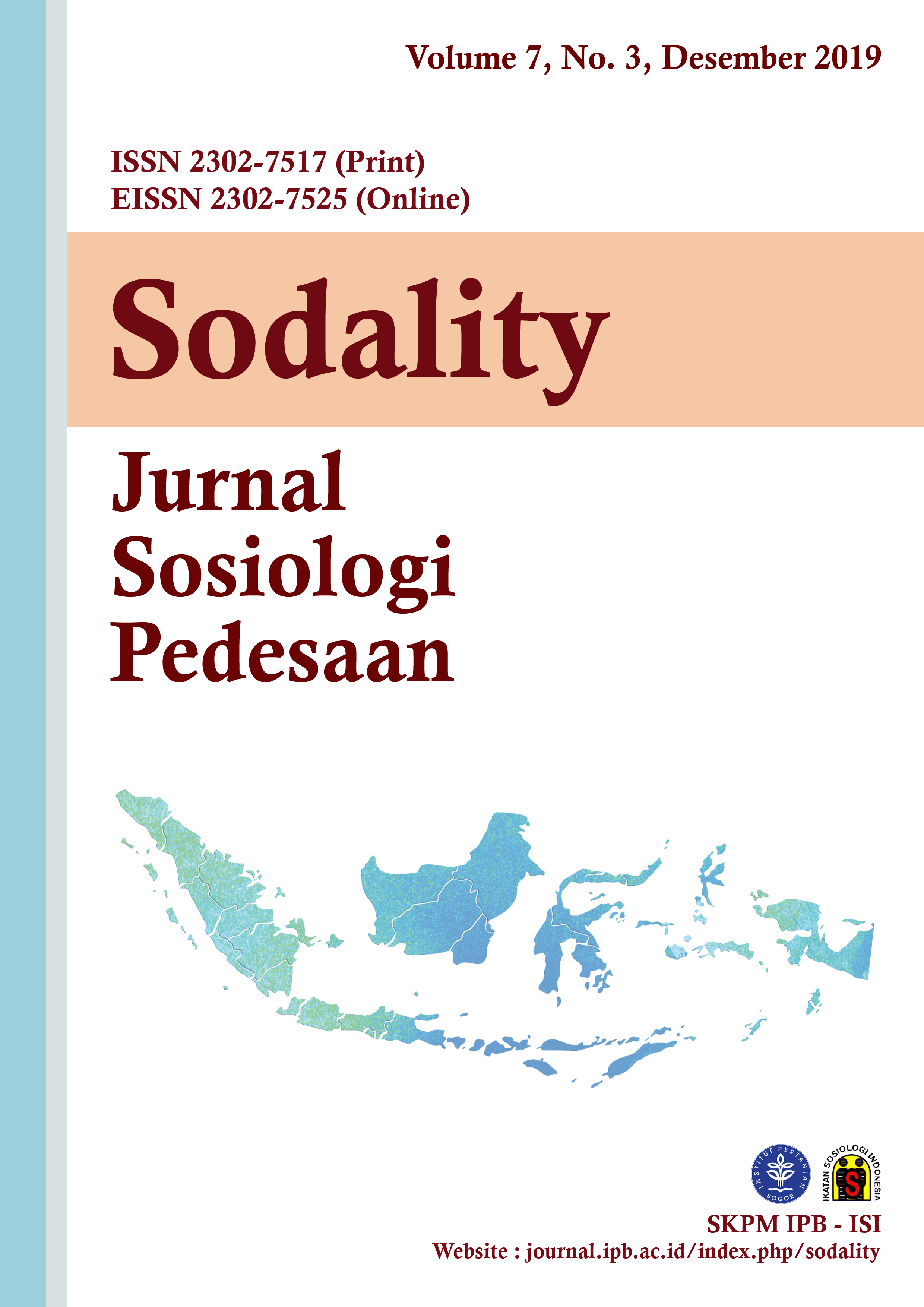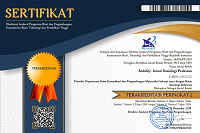The Role of Kewang Customary Institution as a Biosecurity Strategy of Community Livelihood Asset in Negeri Booi
Abstract
Population growth which is not supported with the availability of natural resources causes gaps or limitations in meeting daily needs through natural resources. As a result, rural communities need certain rules or norms used as behavioral guidelines in utilizing the natural resources. One of them is through the existence of kewang customary institution. However, as the community develops, its effectiveness is experiencing a decline. This study examines the role of kewang customary institution as a biosecurity strategy for community livelihood asset in Negeri Booi, Saparua Island, Central Maluku Regency. This study was done in a qualitative manner with a case study method. The key informants involved included members of the kewang, head (raja) of Negeri Booi, farmers and customary leaders. In-depth interviews, observation and focus group discussion (FGD) were used to collect the data. The results showed that the kewang of Negeri Booi played an active role in securing the livelihood asset while at the same time protecting Negeri Booi's territory. However, the inclusion of economic interventions left the kewang members vulnerable. They were faced with the choice to carry out their duties and functions as a local institution securing the livelihood asset or to violate the convention to meet their daily household needs. In general, the community in Negeri Booi still recognized the existence of kewang customary institution by respecting and carrying out every decision taken.
References
Barro, Robert J. and Rachel M. McCleary. 2002. Religion and Political Economy in an International Panel. Working Paper Series 8931.
Batlajery, Adrana, August E. Pattiselanno, and Leunard O. Kakisina. 2018. “Konflik Agraria Di Desa Watmuri Kecamatan Nirunmas Kabupaten Maluku Tenggara Barat.” Agrilan: Jurnal Agribisnis Kepulauan 5(2):88.
Biswarup, Saha and Bahal Ram. 2010. “Livelihood Diversification Pursued by Farmers in West Bengal.” Indian Research Journal of Extension Education 10(2):1–9.
Burgess, C. Paul, F. H. Johnston, D. M. J. S. Bowman, and P. J. Whitehead. 2005. “Healthy Country: Healthy People? Exploring the Health Benefits of Indigenous Natural Resource Management.” Australian and New Zealand Journal of Public Health 29(2):117–22.
Cahyono, Tri, Dwi Budi Santoso, and Iswan Noor. 2017. “Akulturasi Nilai Lokal: Analisis Tata Kelola Alas Gumitir Dalam Pembangunan Perekonomian Masyarakat Desa.” JEPE: Jurnal Ekonomi Pembangunan 15(50–70):1689–99.
Challen, Ray and Steven Schilizzi. 1999. “History, Statics and Options: Transaction Costs in Institutional Change for Water Resources.” in 43rd Annual Conference of the Australian Agricultural and Resource Economics Society. Christchurch: Australian Agricultural and Resource Economics Society.
Chang, Ha-Joon. 2003. “Breaking the Mould: An Institutionalist Political Economy Alternative to the Neoliberal Theory of the Market and the State.” The Journal of Developing Areas 37(1):180–81.
Chua, Ryan Yumin, Amudha Kadirvelu, and Shajahan Yasin. 2019. “The Cultural, Family and Community Factors for Resilience in Southeast Asian Indigenous Communities: A Systematic Review.” Journal of Community Psychology 47(7):1750–71.
Diartho, Herman Cahyo. 2018. “Pengembangan Wilayah Perdesaan Berbasis Pada Potensi Sumber Daya Alam Di Kabupaten Bondowoso Development of Rural Areas Based on Potential Natural Resources in Bondowoso Regency.” Ekonomikawan: Jurnal Ilmu Ekonomi Dan Studi Pembangunan 18(2):102–22.
Ellis, Frank. 1999. Rural Livelihood Diversity in Developing Countries: Evidence and Policy Implications. 40. London: Overseas Development Institute.
Etlegar, Dahlan. 2013. “Peran Lembaga Adat Sasi Dalam Pengelolaan Sumberdaya Dusun Di Negeri Allang Kecamatan Leihitu Barat, Kabupaten Maluku Tengah.” Intitut Pertanian Bogor.
Helmsing, A. H. J. 2003. “Local Economic Development: New Generations of Actors, Policies and Instruments for Africa.” Public Administration and Development 23(1):67–76.
Holzinger, Katharina, Roos Haer, Axel Bayer, Daniela M. Behr, and Clara Neupert-Wentz. 2019. “The Constitutionalization of Indigenous Group Rights, Traditional Political Institutions, and Customary Law.” Comparative Political Studies 52(12):1775–1809.
Judge, Zulfikar and Marissa Nurizka. 2008. “Peranan Hukum Adat Sasi Laut Dalam Melindungi.” Lex Jurnalica 6(1):1–32.
Karepesina, Sakina Safarina and Edi Susilo. 2013. “Kabupaten Maluku Tengah Existence of Customary Law in Protecting the Conservation of Sasiin Haruku Central.” Jurnal ESCOFim 1(1):25–41.
Lyver, P. O. B., P. Timoti, T. Davis, and J. M. Tylianakis. 2019. “Biocultural Hysteresis Inhibits Adaptation to Environmental Change.” Trends in Ecology and Evolution 34(9):771–80.
Malthus, T. Roberth. 1798. An Essay On The Principle Of Population. London.
Nasdian, Fredian Tonny. 2014. Pengembangan Masyarakat. Jakarta: Yayasan Pustaka Obor.
Nasrul, Wedy. 2017. “Peran Kelembagaan Lokal Untuk Penguatan Pasar Pertanian Gambar (Uncarian Gambir Roxb).” Sodality: Jurnal Sosiologi Pedesaan 4(1):47–51.
Nendissa, Andriana Ritje. 2014. “Pengaruh Sosial Ekonomi Kewang Terhadap Pelaksanaan Sasi (Studi Kasus Desa Ihamahu Kecamatan Saparua Kabupaten Maluku Tengah.” Agrilan: Jurnal Agribisnis Kepulauan 2(2):25–37.
Niemeijer, David and Valentina Mazzucato. 2003. “Moving beyond Indigenous Soil Taxonomies: Local Theories of Soils for Sustainable Development.” Geoderma 111(3–4):403–24.
North, Douglass C. 1990. Institutions, Institutional Change, and Economic Performance. Political. New York: Cambridge University Press.
Ohorella, Syarif, Didik Suharjito, and Iin Ichwandi. 2012. “Efektivitas Kelembagaan Lokal Dalam Pengelolaan Sumber Daya Hutan Pada Masyarakat Rumahkay Di Seram Bagian Barat, Maluku (The Effectiveness of Local Institution in Forest Resources Management in Rumahkay Community, Western Seram District, Maluku).” Jurnal Manajemen Hutan Tropika 17(2):49–55.
Oktalina, Silvi Nur, Priyono Suryanto, and Slamet Hartono. 2015. “Strategi Petani Hutan Rakyat Dan Kontribusinya Terhadap Penghidupan Di Kabupaten Gunungkidul.” Jurnal Kawistara 5(3):221–328.
Ostrom, Elinor. 1992. “Governing the Commons: The Evolution of Institutions for Collective Action.” Natural Resources Journal 32(2):415–17.
Pietersz, Jemmy J. 2010. “Fungsi Dan Peran Lembaga Kewang Dalam Perlindungan Lingkungan Di Maluku.” Jurnal Konstitusi 2(1):1–22.
Putri, Eka Intan Kumala, Arya Hadi Dharmawan, Rizka Amalia, and Nurmala K. Pandjaitan. 2006. “Strategi Adaptasi Sosial Ekonomi Dan Ekologi Rumah Tangga Petani Di Daerah Ekspansi Perkebunan Kelapa Sawit (Studi Kasus Di Dua Desa Di Kalimantan Tengah).” Sodality: Jurnal Sosiologi Pedesaan 6(2):105–11.
Rogers, Sarah. 2014. “Betting on the Strong: Local Government Resource Allocation in China’s Poverty Counties.” Journal of Rural Studies 36:197–206.
Ruhulessin. 1985. “Peranan Korps Kewang Dalam Melestarikan Lingkungan Di Kepulauan Lease.” Hukum Dan Pembangunan 15(4):358–69.
Semenda, Dmytro and Olga Semenda. 2018. “Assessment of Ecological and Economic Efficiency of Agricultural Lands Preservation.” Environmental Economics 9(1):47–56.
Shohibuddin, Mohamad. 2016. “Peluang Dan Tantangan Undang-Undang Desa Dalam Upaya Demokratisasi Tata Kelola Sumber Daya Alam Desa: Perspektif Agraria Kritis.” MASYARAKAT: Jurnal Sosiologi 21(1):1–33.
Soleh, Ahmad. 2017. “Strategi Pengembangan Potensi Desa.” Jurnal Sungkai 5(1):32–52.
Syahputra, Gita. 2017. “Biosafety Dan Biosecurity: Upaya Untuk Aman Bekerja Di Laboratorium.” BioTrends 8(1):34–38.
Turner, Rachel A., Jane Addison, Adrian Arias, Brock J. Bergseth, Nadine A. Marshall, Tiffany H. Morrison, and Renae C. Tobin. 2016. “Trust, Confidence, and Equity Affect the Legitimacy of Natural Resource Governance.” Ecology and Society: A Journal of Integrative Science for Resilience and Sustainability 21(3):18.
Uprety, Yadav, Ram C. Poudel, Krishna K. Shrestha, Sangeeta Rajbhandary, Narendra N. Tiwari, Uttam B. Shrestha, and Hugo Asselin. 2012. “Diversity of Use and Local Knowledge of Wild Edible Plant Resources in Nepal.” Journal of Ethnobiology and Ethnomedicine 8:16.
Yustika, A. E. 2012. Ekonomi Kelembagaan. Paradigm, Teori Dan Kebijakan. Indonesia: Penerbit Erlangga, Ciracas. Jakarta.
Authors who publish with this journal agree to the following terms:
- Authors retain copyright and grant the journal right of first publication with the work simultaneously licensed under a

This work is licensed under a Creative Commons Attribution 4.0 International License. that allows others to share the work with an acknowledgement of the work's authorship and initial publication in this journal. - Authors are able to enter into separate, additional contractual arrangements for the non-exclusive distribution of the journal's published version of the work (e.g., post it to an institutional repository or publish it in a book), with an acknowledgement of its initial publication in this journal.
- Authors are permitted and encouraged to post their work online (e.g., in institutional repositories or on their website) prior to and during the submission process, as it can lead to productive exchanges, as well as earlier and greater citation of published work (See The Effect of Open Access).





.png)









